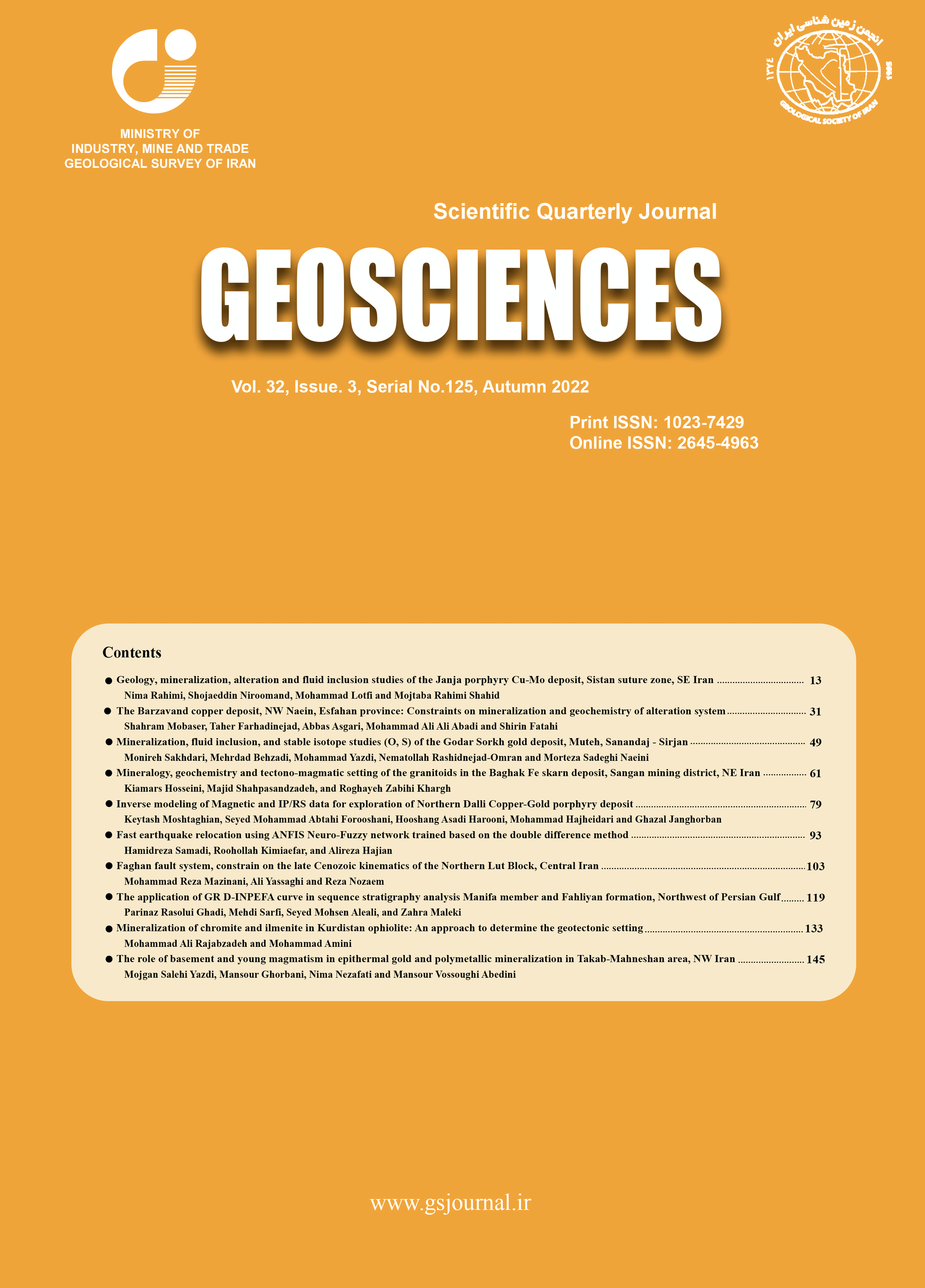Document Type : Original Research Paper
Authors
1 Department of Petroleum, Mining and Material Engineering, Central Tehran Branch, Islamic Azad University, Tehran, Iran
2 Department of Physics, Najafabad Branch, Islamic Azad University, Najafabad, Iran
Abstract
One of the most important issues in seismology is to accurately determine the epicenter of earthquake, mainly because the accuracy of dependent studies such as seismic risk analysis, fault mechanism, depends on the accuracy of mentioned parameter. Double difference method is one of the conventional relative earthquake relocation methods which is used vastly by seismological centers and it is used as the basis of an algorithm that relocates earthquake events about 0.004 second. In the proposed method, Adaptive Neuro-Fuzzy Inference System (ANFIS) is trained based on the former relocated events and generalized for new earthquakes. In the training procedure, the hypocentral information, for the main event and the nearest one (determined by K nearest neighbor search), and the velocity model of the region are considered as inputs and hypocentral information are set as target for the network. Here, with reference to the information of about 8000 earthquakes, as the training events, 490 earthquakes were relocated in about 0.1 (s) where RMS for predicating latitude and longitude of the events were 0.002 and for the depth parameter, RMS was 0.45. It is concluded that the proposed method could be considered as a powerful algorithm for near real time relocation of earthquakes.
Keywords
Main Subjects
Douglas, A., 1967. Joint epicenter determination. Nature, 215: 47-48.doi.org/10.1038/215047a0.
Florez, M. A., and Prieto, G. A, 2017. Precise relative earthquake depth determination using array processing techniques. Journal of Geophysical Research: Solid Earth, 122: 4559– 4571, doi.org/10.1002/2017JB014132.
Frechet, J., 1985. Seismogenes et Doublet of Sismiques, ph.D, Thesis, University of Grenoble.
Geiger, L., 1910. Herdbestimming bei erdbeben aus den ankunftszeiten, K. Ges. wiss Go, European Digital Mathematics Library, 4: 331-349.
Geiger,L., 1912. Probability Method for Determination of Earthquake Epicenters from the Arrival Time only: Louis University, 8: 56-71.
Ghayoumian, J., and Fatahi, M.A., 2003. Evaluation of Landslide Hazard Zonation Models in Latin Dam Watershed. Journal of Engineering Geology, 1: 24-41.
Got, J.L., 1994. Deep Fault Plane Geometry Inferred from Multiple Relative Relocation Beneath the South flank of Kilauea. Journal of Geophysical Research: Solid Earth, 99: 15375-15386. doi.org/10.1029/94JB00577.
Grecksch, G., Kümpel, H.J., 1997. Statistical analysis of strong-motion accelerograms and its application to earthquake early-warning systems. Geophysical Journal International, 129: 113-123. https://doi.org/10.1111/j.1365-246X.1997.tb00940.x.
Hajian, A., Kimiaefar, R. and Siahkoohi, HR., 2016. Random Noise Attenuation in Reflection Seismic Data Using Adaptive Neuro-fuzzy Interference System (ANFIS). 78th EAGE Conference and Exhibition 2016, 2016: 1-5. doi.org/10.3997/2214-4609.201601589.
Husen, S., and Hardebeck, J.L., 2010. Earthquake location accuracy, Community Online Resource for Statistical Seismicity Analysis, doi.org/10.5078/corssa-55815573.
Jang, J.SR., 1993. ANFIS:Adaptive-Network-Based Fuzzy Inference System. IEEE Transactions on Systems Man and Cybernetics, 23: 665-685. doi.org/10.1109/21.256541.
Kamranzad, F., Memarian, F. and Zare, M., 2020. Earthquake risk Assessment for Tehran, Iran. International Journal of Geo-Information, 9: 1-12. doi.org/10.3390/ijgi9070430.
Kayal, J.R., 2008. Micro earthquake seismology and seismotectonic of South Asia. Springer book, 105-108.
Kimiaefar, R., Siahkoohi, HR., Hajian, A. and Kalhor, A., 2018. Random noise attenuation by Wiener-ANFIS filtering. Journal of Applied Geophysics, 159: 453-459. doi.org/10.1016/j.jappgeo.2018.05.017.
Mottaghi, A., Rezapour, M. and Yaminifard , F., 2010. Double Difference Relocation of Earthquake Hypocenters along the Southern flank of the Central Alborz Iran. Bulletin of the Seismological society of America, 100: 2014-2023. doi.org/10.1785/0120090147.
Pavlis, G., 1983. Progressive multiple event location. Bulletin of the Seismological society of America, 73: 1753-1757. doi.org/10.1785/BSSA07306A1753.
Prejean, S., Ellsworth. W L., Zoback, M., and Waldhauser, F., 2002. Fault Structure and Kinematics of the Long Valley Caldera Region California. Journal of Geophysical Research Atmospheres, 107: 1-9. doi.org/10.1029/2001JB001168.
Radan, M.Y., Hamzehloo, H., Peresan, A., Zare, M., and Zafarani, H., 2013. Assessing performances of pattern informatics method: a retrospective analysis for Iran and Italy.Natural Hazards, 68: 855–881. doi.org/10.1007/s11069-013-0660-8.
Romanowicz, B., 2008. Using seismic waves to image Earth internal structure. Nature,451:266-268. doi.org/10.1038/nature06583.
Takagi,T., and Sugeno, M., 1985. Fuzzy Identification of Systems and Its Application to Modeling and Control. IEEE Transactions on Systems Man and Cybernetics, 15: 116-132. doi.org/10.1109/TSMC.1985.6313399.
Waldhauser, F., 2000. A Double-Difference earthquake location Algorithm Method and Application to the Northern Hayward Fault. Bulletin of the Seismological society of America, 90: 1353-1368. doi.org/10.1785/0120000006.
Waldhauser, F., 2009. Near-Real-Time Double Difference Event Location Using Long-Term Seismic Archives with Application Northern California. Bulletin of the Seismological Society of America, 99: 2736-2748. doi.org/10.1785/0120080294.
Wolf, C.J., 2002. On the Mathematics of using Difference Operators to Relocate Earthquake. Bulletin of the Seismological society of America, 92: 2879-2892. doi.org/10.1785/0120010189.

